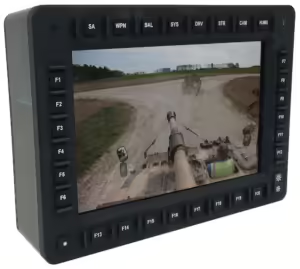We have had a bit of talk on these pages about the Department of Defense and displays so, if you want to get a feel for the real deal you might want to head over to the 2024 AUSA Annual Meeting and Exposition, taking place in Washington, DC, from October 14th to 16th. It’s an event for military professionals and organizations to showcase products and services relevant to defense and security.
I don’t know much else about it and probably wouldn’t even be allowed near the place but I found out about it because I got news from IEE, a manufacturer specializing in military displays. The company is known for developing low-latency video display technology tailored for military applications, particularly in the context of autonomous vehicles.
The company’s going to be showcasing the following two LCD displays. Like I always says, it takes all kinds of screens to make a display industry.
| 10.1-inch Multi-Function Display (MFD) | Specification |
| Resolution | WUXGA (1920×1200) |
| Pixel Density | >220 ppi |
| Brightness | Dual-mode LED backlight (1,100 cd/m² for day, NVIS B compliant for night) |
| Touchscreen | High-strength multi-touch with ARAGAS treatments |
| Control Features | – 31 programmable bezel pushbuttons – 3 rocker switches with tactile feedback – Programmable dual-concentric encoder – 8-way joystick with pushbutton |
| Enclosure | Lightweight, rugged, sealed for cockpit avionics |
| Video Inputs | 2x DVI, 2x 3G-SDI |
| Control Interface | Bezel RS-422, Touchscreen RS-422, Discrete IO |
| 13.3-inch FHD Operator Display Panel | Specification |
| Resolution | Full-HD (1920×1080), 4K (332 ppi) in development |
| Brightness | High-bright LED backlight (day and NVIS compatible for night) |
| Display Features | Bonded with high-strength cover glass, EMI shield, heater, anti-reflective/glare treatments |
| Bezel Layout | 8 backlit soft keys |
| Video Inputs | 2x Composite NTSC/PAL, 1x 3G-SDI |
| Communication | Serial communication bus |
This got me all curious about what standards these displays have to adhere to and rugged displays for military use are built to meet rigorous military standards (MIL-STD). One of the key specifications is MIL-STD-810, which tests these displays for things like extreme temperatures, rain, humidity, dust, immersion in water, vibration, and shock. These tests are designed to mimic the conditions a display might face in the field.
Another important standard is MIL-STD-461, which makes sure the display doesn’t interfere with other electronics by controlling electromagnetic interference (EMI) and radio frequency interference (RFI). For displays that might face heavy impacts or even explosive shocks, MIL-DTL-901 is the go-to standard for shock resistance. If the display is going to be used in vehicles, ships, or aircraft, MIL-STD-167 comes into play to address things like mechanical vibrations.
In addition to military standards, many rugged displays are also rated for protection against dust and water with IP65 or IP66 certifications. Some even have TEMPEST certification, which safeguards against the leakage of electromagnetic signals to protect sensitive information.
To meet these stringent requirements, rugged military displays are designed with features like high-brightness screens for readability in direct sunlight, wide temperature ranges to handle both hot and cold environments, and optical bonding to make the screens more durable and easier to see. They’re usually enclosed in sealed, water-resistant cases and often use fanless designs to keep out dust. On top of that, the internal components are often coated with protective materials to further boost durability.

